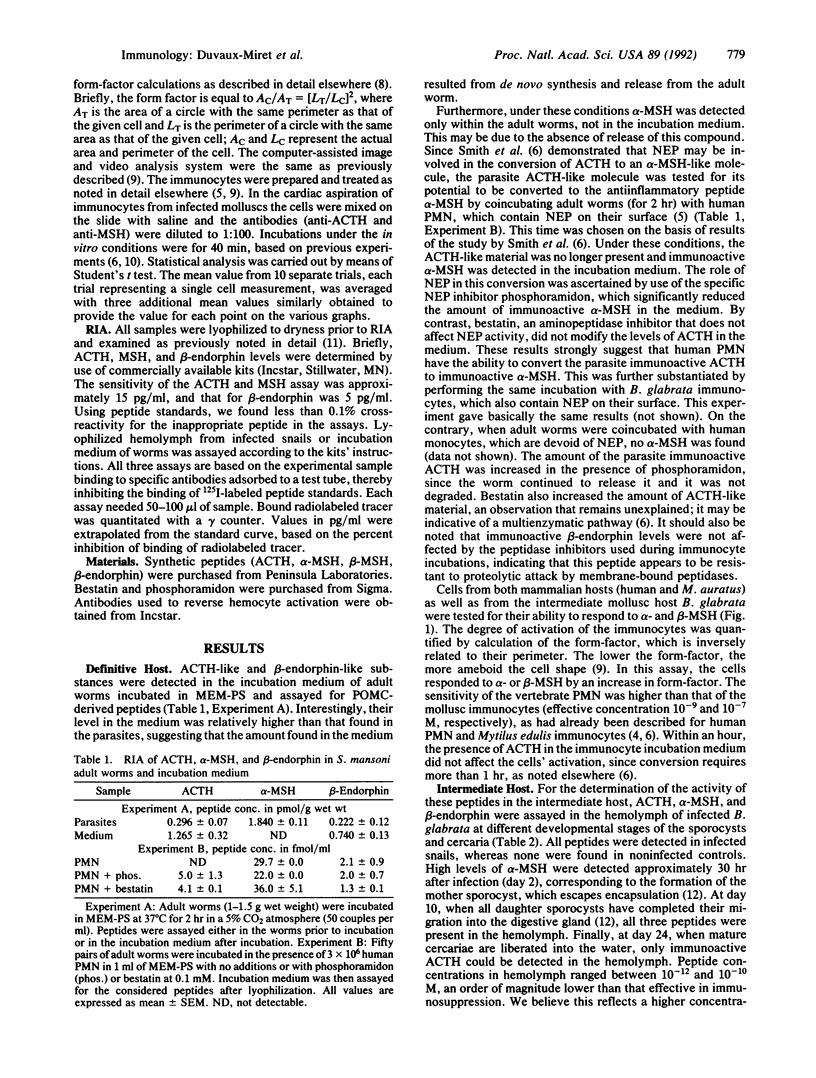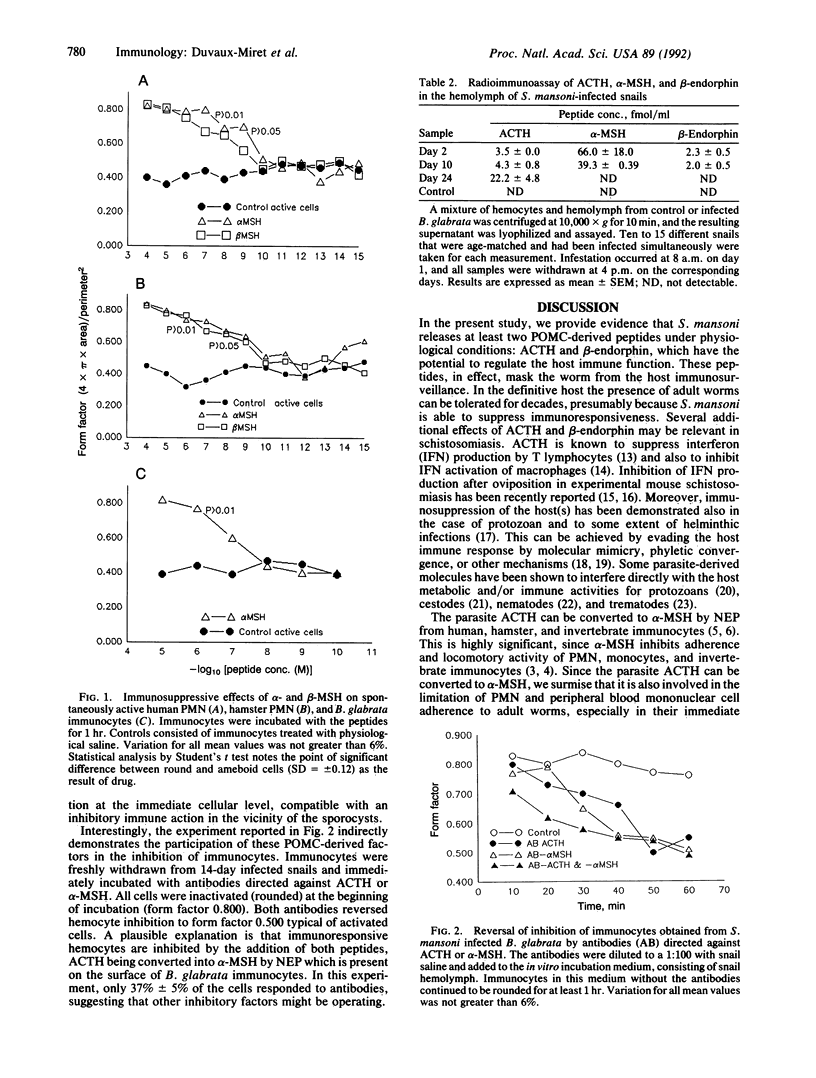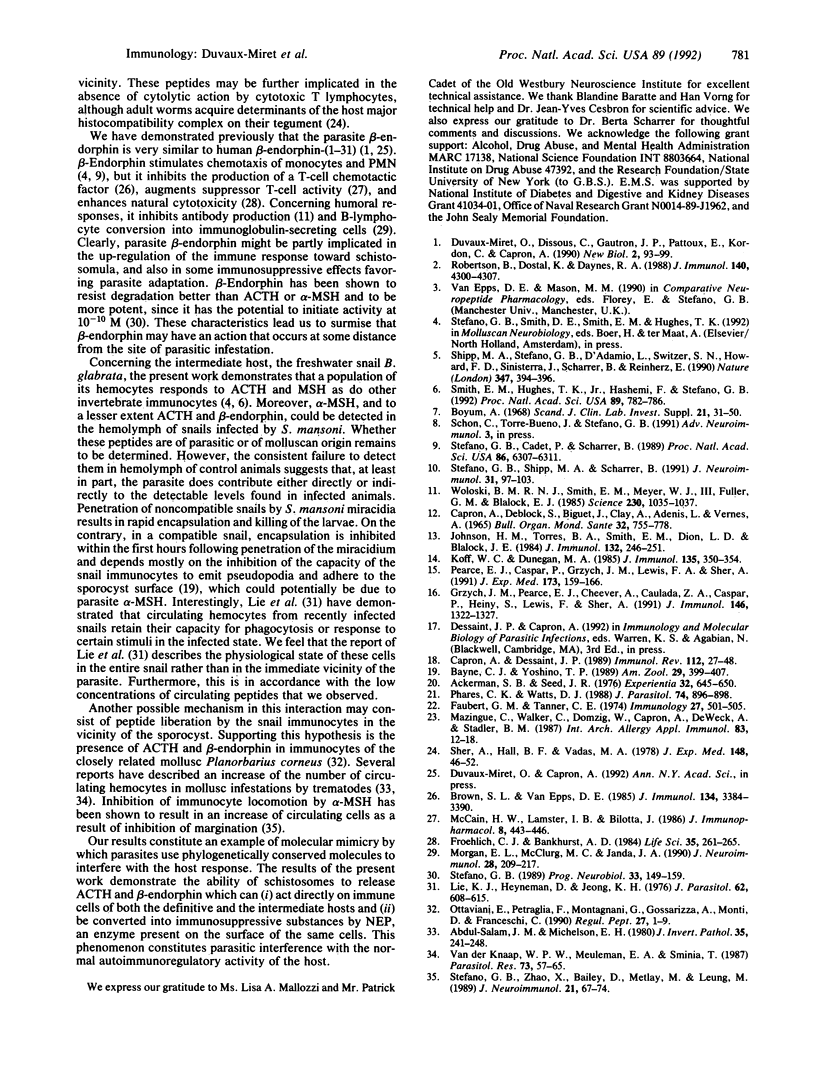Abstract
Evidence supporting the concept that the parasitic trematode Schistosoma mansoni may escape immune reactions from its vertebrate (man) or invertebrate (the freshwater snail Biomphalaria glabrata) hosts by using signal molecules it has in common with these hosts was obtained by the following experiments. The presence of immunoactive proopiomelanocortin (POMC)-derived peptides [corticotropin (ACTH), beta-endorphin] in, and their release from, S. mansoni was demonstrated. Coincubation of adult worms with human polymorphonuclear leukocytes or B. glabrata immunocytes led to the appearance of alpha-melanotropin (MSH) in the medium. The conclusion that this alpha-MSH resulted from conversion of the parasite ACTH by neutral endopeptidase 24.11 (NEP) present on these cells was supported by the fact that the alpha-MSH level in the medium was markedly reduced by addition of the specific NEP inhibitor phosphoramidon. This interpretation is substantiated by the fact that no conversion was observed in comparable tests with human monocytes, which exhibit no NEP activity. alpha-MSH has the capacity to inactivate formerly active immunocytes not only from the definitive host (man, hamster) but also from the intermediate host (B. glabrata), as determined by microscopic computer-assisted examination of conformational changes. POMC-derived peptides have been detected in B. glabrata hemolymph 2, 10, and 24 days after infection by S. mansoni miracidia. Immunocytes from infected snails were found to be inactivated, and this inactivation was prevented by antibodies directed against ACTH and alpha-MSH. The immunoactive beta-endorphin released from S. mansoni does not appear to be subject to enzymatic conversion. Since it is active at lower concentrations, it may be used for distant signaling.
Full text
PDF



Selected References
These references are in PubMed. This may not be the complete list of references from this article.
- Abdul-Salam J. M., Michelson E. H. Biomphalaria glabrata amoebocytes: effect of Schistosoma mansoni infection on in vitro phagocytosis. J Invertebr Pathol. 1980 May;35(3):241–248. doi: 10.1016/0022-2011(80)90157-3. [DOI] [PubMed] [Google Scholar]
- Ackerman S. B., Seed J. R. The effects of tryptophol on immune responses and it implications toward trypanosome-induced immunosuppression. Experientia. 1976 May 15;32(5):645–647. doi: 10.1007/BF01990212. [DOI] [PubMed] [Google Scholar]
- Brown S. L., Van Epps D. E. Suppression of T lymphocyte chemotactic factor production by the opioid peptides beta-endorphin and met-enkephalin. J Immunol. 1985 May;134(5):3384–3390. [PubMed] [Google Scholar]
- Böyum A. Isolation of leucocytes from human blood. Further observations. Methylcellulose, dextran, and ficoll as erythrocyteaggregating agents. Scand J Clin Lab Invest Suppl. 1968;97:31–50. [PubMed] [Google Scholar]
- Capron A., Deblock S., Biguet J., Clay A., Adenis L., Vernes A. Contribution à l'étude expérimentale de la bilharziose à Schistosoma haematobium. Bull World Health Organ. 1965;32(6):755–778. [PMC free article] [PubMed] [Google Scholar]
- Capron A., Dessaint J. P. Molecular basis of host-parasite relationship: towards the definition of protective antigens. Immunol Rev. 1989 Dec;112:27–48. doi: 10.1111/j.1600-065x.1989.tb00551.x. [DOI] [PubMed] [Google Scholar]
- Duvaux-Miret O., Dissous C., Gautron J. P., Pattou E., Kordon C., Capron A. The helminth Schistosoma mansoni expresses a peptide similar to human beta-endorphin and possesses a proopiomelanocortin-related gene. New Biol. 1990 Jan;2(1):93–99. [PubMed] [Google Scholar]
- Faubert G. M., Tanner C. E. The suppression of sheep rosette-forming cells and the inability of mouse bone marrow cells to reconstitute competence after infbction with the nematode Trichinella spiralis. Immunology. 1974 Sep;27(3):501–505. [PMC free article] [PubMed] [Google Scholar]
- Froelich C. J., Bankhurst A. D. The effect of beta-endorphin on natural cytotoxicity and antibody dependent cellular cytotoxicity. Life Sci. 1984 Jul 16;35(3):261–265. doi: 10.1016/0024-3205(84)90109-7. [DOI] [PubMed] [Google Scholar]
- Grzych J. M., Pearce E., Cheever A., Caulada Z. A., Caspar P., Heiny S., Lewis F., Sher A. Egg deposition is the major stimulus for the production of Th2 cytokines in murine schistosomiasis mansoni. J Immunol. 1991 Feb 15;146(4):1322–1327. [PubMed] [Google Scholar]
- Johnson H. M., Torres B. A., Smith E. M., Dion L. D., Blalock J. E. Regulation of lymphokine (gamma-interferon) production by corticotropin. J Immunol. 1984 Jan;132(1):246–250. [PubMed] [Google Scholar]
- Koff W. C., Dunegan M. A. Modulation of macrophage-mediated tumoricidal activity by neuropeptides and neurohormones. J Immunol. 1985 Jul;135(1):350–354. [PubMed] [Google Scholar]
- Lie K. J., Heyneman D., Jeong K. H. Studies on resistance in snails. 7. Evidence of interference with the defense reaction in Biomphalaria glabrata by trematode larvae. J Parasitol. 1976 Aug;62(4):608–615. [PubMed] [Google Scholar]
- Mazingue C., Walker C., Domzig W., Capron A., De Weck A., Stadler B. M. Effect of schistosome-derived inhibitory factor on the cell cycle of T lymphocytes. Int Arch Allergy Appl Immunol. 1987;83(1):12–18. doi: 10.1159/000234324. [DOI] [PubMed] [Google Scholar]
- McCain H. W., Lamster I. B., Bilotta J. Modulation of human T-cell suppressor activity by beta endorphin and glycyl-L-glutamine. Int J Immunopharmacol. 1986;8(4):443–446. doi: 10.1016/0192-0561(86)90130-x. [DOI] [PubMed] [Google Scholar]
- Morgan E. L., McClurg M. R., Janda J. A. Suppression of human B lymphocyte activation by beta-endorphin. J Neuroimmunol. 1990 Aug;28(3):209–217. doi: 10.1016/0165-5728(90)90014-e. [DOI] [PubMed] [Google Scholar]
- Ottaviani E., Petraglia F., Montagnani G., Cossarizza A., Monti D., Franceschi C. Presence of ACTH and beta-endorphin immunoreactive molecules in the freshwater snail Planorbarius corneus (L.) (Gastropoda, Pulmonata) and their possible role in phagocytosis. Regul Pept. 1990 Jan;27(1):1–9. doi: 10.1016/0167-0115(90)90200-g. [DOI] [PubMed] [Google Scholar]
- Pearce E. J., Caspar P., Grzych J. M., Lewis F. A., Sher A. Downregulation of Th1 cytokine production accompanies induction of Th2 responses by a parasitic helminth, Schistosoma mansoni. J Exp Med. 1991 Jan 1;173(1):159–166. doi: 10.1084/jem.173.1.159. [DOI] [PMC free article] [PubMed] [Google Scholar]
- Phares C. K., Watts D. J. The growth hormone-like factor produced by the tapeworm Spirometra mansonoides specifically binds receptors on cultured human lymphocytes. J Parasitol. 1988 Oct;74(5):896–898. [PubMed] [Google Scholar]
- Robertson B., Dostal K., Daynes R. A. Neuropeptide regulation of inflammatory and immunologic responses. The capacity of alpha-melanocyte-stimulating hormone to inhibit tumor necrosis factor and IL-1-inducible biologic responses. J Immunol. 1988 Jun 15;140(12):4300–4307. [PubMed] [Google Scholar]
- Sher A., Hall B. F., Vadas M. A. Acquisition of murine major histocompatibility complex gene products by schistosomula of Schistosoma mansoni. J Exp Med. 1978 Jul 1;148(1):46–57. doi: 10.1084/jem.148.1.46. [DOI] [PMC free article] [PubMed] [Google Scholar]
- Shipp M. A., Stefano G. B., D'Adamio L., Switzer S. N., Howard F. D., Sinisterra J., Scharrer B., Reinherz E. L. Downregulation of enkephalin-mediated inflammatory responses by CD10/neutral endopeptidase 24.11. Nature. 1990 Sep 27;347(6291):394–396. doi: 10.1038/347394a0. [DOI] [PubMed] [Google Scholar]
- Smith E. M., Hughes T. K., Jr, Hashemi F., Stefano G. B. Immunosuppressive effects of corticotropin and melanotropin and their possible significance in human immunodeficiency virus infection. Proc Natl Acad Sci U S A. 1992 Jan 15;89(2):782–786. doi: 10.1073/pnas.89.2.782. [DOI] [PMC free article] [PubMed] [Google Scholar]
- Stefano G. B., Cadet P., Scharrer B. Stimulatory effects of opioid neuropeptides on locomotory activity and conformational changes in invertebrate and human immunocytes: evidence for a subtype of delta receptor. Proc Natl Acad Sci U S A. 1989 Aug;86(16):6307–6311. doi: 10.1073/pnas.86.16.6307. [DOI] [PMC free article] [PubMed] [Google Scholar]
- Stefano G. B. Role of opioid neuropeptides in immunoregulation. Prog Neurobiol. 1989;33(2):149–159. doi: 10.1016/0301-0082(89)90038-5. [DOI] [PubMed] [Google Scholar]
- Stefano G. B., Shipp M. A., Scharrer B. A possible immunoregulatory function for [Met]-enkephalin-Arg6-Phe7 involving human and invertebrate granulocytes. J Neuroimmunol. 1991 Feb;31(2):97–103. doi: 10.1016/0165-5728(91)90015-y. [DOI] [PubMed] [Google Scholar]
- Stefano G. B., Zhao X. H., Bailey D., Metlay M., Leung M. K. High affinity dopamine binding to mouse thymocytes and Mytilus edulis (Bivalvia) hemocytes. J Neuroimmunol. 1989 Jan;21(1):67–74. doi: 10.1016/0165-5728(89)90160-4. [DOI] [PubMed] [Google Scholar]
- Woloski B. M., Smith E. M., Meyer W. J., 3rd, Fuller G. M., Blalock J. E. Corticotropin-releasing activity of monokines. Science. 1985 Nov 29;230(4729):1035–1037. doi: 10.1126/science.2997929. [DOI] [PubMed] [Google Scholar]
- van der Knaap W. P., Meuleman E. A., Sminia T. Alterations in the internal defence system of the pond snail Lymnaea stagnalis induced by infection with the schistosome Trichobilharzia ocellata. Parasitol Res. 1987;73(1):57–65. doi: 10.1007/BF00536337. [DOI] [PubMed] [Google Scholar]


